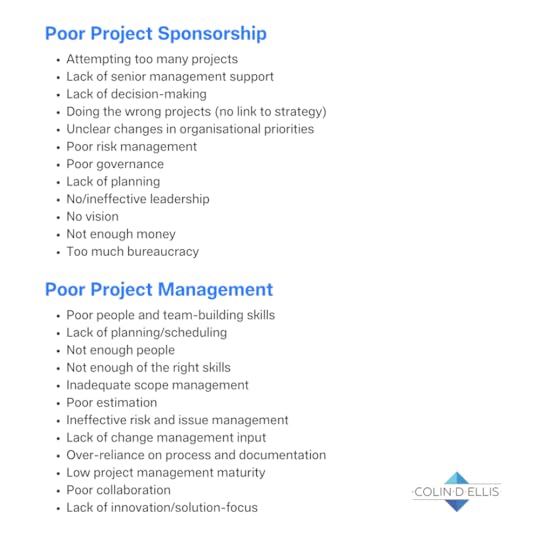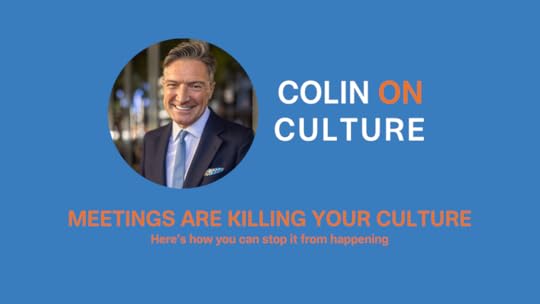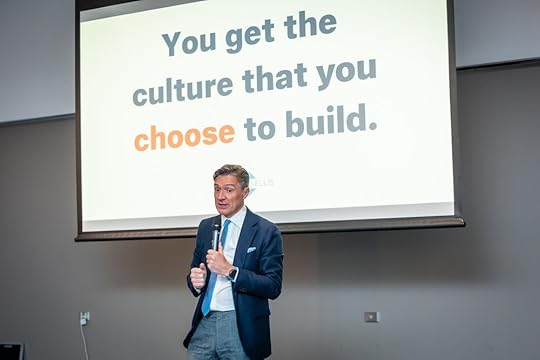Colin D. Ellis's Blog, page 12
June 2, 2025
Why projects always fail (and how to fix them)
The ‘Lessons Learned’ document is popular in organisations that deliver projects. Essentially, when a mistake is made, the lesson (i.e. a description of what needs to be avoided in the future) is added to the document and is assigned an owner. At the end of the project it is reviewed and the ‘lessons’ should then be incorporated into new ways of working by the person responsible.
Despite this process, projects continue to fail for exactly the same reasons as they did when I was a project manager almost 30 years ago. Over time, over budget, lack of planning, not enough people, unclear priorities, poor risk management, the lessons learned list goes on.
To address this problem, organisations need to address the only two real reasons why projects continually fail. They are:
Poor project sponsorship
Poor project management
Every reason for project failure can be linked back to these two reasons. You may argue that it’s too simplistic, yet in my experience of heading up project departments for 10 years, it really isn’t. Here are a list of the most common reasons for failure and how they are connected:

The project sponsor is the individual upon whom accountability rests and every project must have one. They have three key responsibilities:
Provide leadership: Be the figurehead of the project, take public ownership, set the tone for the behaviours required and be available throughout
Make decisions: Ensure that key decisions are made to aid delivery of the project and remove roadblocks on behalf of the project manager
Deliver outcomes: Ensure that the benefits of doing the project in the first place are delivered once the project has been completed
The project manager meanwhile has day-to-day responsibility for task management and product delivery. They have three key responsibilities:
Build the team: Ensure that there is commitment from everyone involved to work together for the success of the project
Build the plan: Ensure that a strong plan (and detailed task list) exists such that people understand when they are needed and what they have to do
Deliver the project: Provide motivation, inspiration and information; managing people, risk, issues and output delivery so the benefits can be achieved
Which brings me to the root cause of continual project failure and that is a woeful investment in building the capabilities of both project sponsors and project managers. After all, if you don’t train your people you can’t expect on time and on budget delivery, yet this continues to be the lived experience for most.
Organisations around the world think nothing of spending £10m on projects in a year, but wouldn’t spend 1% of that (£100,000) on ensuring that people are adequately trained to spend the money wisely and deliver the projects efficiently. It defies logic and reason.
I recently completed a two-day project leadership program and a 1-day project sponsorship program for an organisation and it struck me that a) how rare it is that people are given the money to do this work and b) how immediately they are able to gain from this education, developing:
A common language and understanding
A toolkit of techniques to help plan and deliver
Clarity on priorities
An ability to motivate and inspire people
Enhanced communication; and ultimately
Better able to deliver milestones and hit financial targets
For most however, the underinvestment continues and there’s an assumption that people ‘just know’ what to do.
Once you achieve a particular level in a hierarchy you’re deemed to be experienced enough to be a project sponsor, whilst just about anyone can be told to manage a project, regardless of whether they have the skills or not.
The research confirms the issue:
Less that half of respondents said their organisation provided training despite project management being critical to organisational success
71% of companies believe employees need more project management skills
Whilst:
Organisations that invest in project management save 28 times as much money as those that don't
I loved my time as a project manager and feel fortunate to have been given the support to develop and grow. To avoid continual project failure, organisations should start with educating their people properly first. It's an investment that they’ll reap the benefits from for years to come and a demonstration that they’ve truly learned the lessons from the past.
Subscribe to Colin on Culture Sign up with your email * indicates required Email Address *June 1, 2025
Is nostalgia holding you back?
Nostalgia is an affection for the past and when it comes to work many people yearn for a time long gone.
If nostalgia is put to good use it can provide fuel for a vibrant culture. This includes:
The behaviours required to overcome adversity
The creativity shown to maintain performance
The work done by teams to bridge silos
How leaders evolved their strategy to meet challenges or opportunities
How the team worked together to reject the behaviours of another who sought to undermine safety
These are all elements of a learning culture and when done well ensure that the culture positively evolves based on what’s gone before.
Unfortunately, many people use nostalgia to reject change. Things you will hear include:
‘You can’t say anything these days’
‘The kids today have it easy’
‘Everything is too PC and fluffy today’
‘The way we did things in the past worked just fine’
‘If only we could go back to [insert time period]’
The way that we work has moved on dramatically, even just in the last 5 years and we’re raising children to make more of a contribution in the world. Therefore, wistfully hoping for the sugar-coated memories of previous days to return is a waste of time and energy. It will reinforce aged or experience-based cliques, drain the energy from teams and disengage people looking to make a difference.
Negative nostalgia has no place in vibrant cultures, however, positive stories of human achievement always will. Is your nostalgia pushing you forward or holding you back?
Subscribe to Colin on Culture Sign up with your email * indicates required Email Address *May 29, 2025
There's nothing constructive about criticism
Throughout my career I worked for managers who were great at giving criticism, but who were light on the ways to address what they perceived my flaws to be. I fully recognised (more so as I matured!) that I wasn’t the perfect employee, however - like most people - I wanted to do well and please those around me, whilst maintaining my sense of individualism.
Yet, being on the end of their ‘tough love’ never generated feelings of motivation. In fact it did the opposite. Their criticism served only to drain any enthusiasm I had for the job and led to feelings of inadequacy.
Being a naturally positive person, I like to think that we’ve moved on in the last 20 years, however last week I read a job advertisement and one of the bullet points read ‘the ability to accept criticism and work well under pressure’.
I have no issue with the end of that sentence as being able to demonstrate calmness in stressful situations is a skill that most of us need. Being able to accept criticism however, is a different matter.
Criticism is, by definition, ‘the expression of disapproval of someone or something on the basis of perceived faults or mistakes.’ Therefore, it is always negative and is mostly perceptive, i.e. your assessment (truthful or otherwise) of another’s faults.
It inherently triggers defensive responses that prevent the construction of new thinking or behaviour, which means that there’s nothing constructive about it!
Regular criticism therefore chips away at a person’s self-esteem, confidence and ultimately the psychological safety of a team or organisation. It contains hidden judgements as the basis for criticism is often a difference in approach.
Finally, criticism focuses on problems rather than possibilities, directing energy toward ‘fixing’ weaknesses instead of amplifying strengths.

Alvaro Carias and I giving each other feedback on a presentation for FIFA
What’s required instead is empathetic feedback. You might think this semantic, but words and approach are important, not least when we are looking for changes in the responses of human emotions.
None of us are perfect and we all need feedback to improve who we are and what we do and this feedback should be both positive and negative.
From a team culture perspective, when flaws are continually magnified without strengths being acknowledged, it actively reduces feelings of engagement and belonging and leads to a reduction in productivity. Yet when strengths and successes are acknowledged, the results are quite different with increases seen in almost all areas of company performance.
According to the Gottman Ratio, the perfect amount of positive to negative feedback required to maintain strong relationships is 5:1. That is to say, to get the best out of another person, you need to consistently reinforce what they do well - this is great for confidence and feelings of self-worth - which then provides you with the opportunity to address what could be improved.
It needn’t be gushing, a simple ‘well done’ will suffice, however, when we have been on the receiving end of positive feedback, it makes the negative feedback much easier to take and act upon.
When giving this feedback, rather than just tell people what they need to improve, you need to also provide them with either a) the opportunity to outline how they would address the issue; or b) the tactics required to improve. This is the difference between coaching and mentoring and will differ depending on the situation.
This helps with the absorption of feedback and ensures that the person on the receiving end sees it as a benefit (a way to improve) and not criticism (something wrong with them).
So, what should the advertisement say? It should read ‘The ability to reflect on feedback and work well under pressure.’ Unless of course they just want to criticise their new staff. In which case, it’s a job to avoid!
Subscribe to Colin on Culture Sign up with your email * indicates required Email Address *May 28, 2025
Young people today
Before you bemoan the actions, communication styles or habits of ‘young people today’, it’s worth remembering that you were young once.
When you first came into the workforce - regardless of what you did - you had been raised differently than your parents had been raised. You had access to more information than they had. You had access to technology (even if it was just a calculator!) that they didn’t have and as a result of these things, had different ideas and opinions of the way things should be done.
So, rather than moan about how things have changed and point imaginary fingers at those who have changed them, try empathy and education instead. Keep in mind that you were ‘young people today’ once and expected those who were older to understand you and keep up with newer ways of doing things.
Today’s new employees are no different.
Subscribe to Colin on Culture Sign up with your email * indicates required Email Address *May 27, 2025
Corporate slop
One of the biggest complaints about AI is the level of ‘slop’ that it produces, i.e. low quality media and writing that it outputs from the prompts that it’s given.
The technology will improve over time (the end of 2026 is currently being touted as the date for high-quality AI) and the amount of ‘slop’ it produces will lessen.
However, organisations that are waiting for AI to improve productivity can achieve their goals right now by ridding themselves of the corporate slop that they have allowed to take root.
Corporate slop has been bogging employees down for years. Needless processes, complicated forms, behaviours that have never been dealt with, endless emails about nothing in particular, pet projects that add no value to the organisation, meetings that are 10-15 minutes longer than they need to be and time wasted reacting to the latest whim.
These are all examples of activities and actions that prevent people from doing work to increase outputs and consequently, results.
Rather than waiting for technology to solve productivity problems, leaders can create an exciting pathway instead by removing the corporate slop that will allow employees to embrace the gains that AI can - eventually - provide.
Subscribe to Colin on Culture Sign up with your email * indicates required Email Address *May 26, 2025
Culture doesn’t belong to HR
When I was researching my latest book Detox Your Culture (recently shortlisted for a Business Book of the Year award, get your copy here) I kept encountering the same misconception in all of the case studies I read: that HR departments have full responsibility for day-to-day culture within an organisation and as such, if there was toxicity, then they were to blame.
However, as we’ll see, culture is never solely HR's responsibility (and any seasoned HR Manager would agree!) They can’t be there every minute of every day telling people how to behave, interact and work together
The culture of any team or organisation belongs to everyone that shows up for work each day, regardless of whether they’ve been employed for 5 minutes or 50 years. So where do HR or the People and Culture team fit in then?
HR acts as the cultural architect; drafting strategies, securing the money for learning, tools and evolution, and reporting to leadership on issues that need addressing.
They should lead the process of defining values, ensuring they remain relevant in line with the organisation’s strategy and equip managers with the skills and knowledge to implement them.
They should coordinate pulse surveys and ensure action plans fall to the managers actually responsible for culture, with appropriate consequences for those who don't follow through and improve the daily lives of employees.
Which means that they also have the responsibility to implement policies that safeguard the organisation's reputation and employee safety. They should enforce these when anyone (regardless of title or status) undermines the culture through their actions or behaviours.
They encourage activities that positively evolve culture - including working with facilities on office space (if required) - and ensure fair, equitable pay and working conditions for all.
But when it comes to culture, that's where it ends.
The lived experience - "how we do things around here" - belongs to everyone, with managers having the most direct influence over what people experience day-to-day.
When HR Directors hire me, it's to deliver on their promise to managers - equipping them with the skills to build vibrant cultures (skills they're measured on annually). Forward-thinking HR teams also use the opportunity to sharpen their own skills, as they rarely have time to keep pace with global culture trends and practices.
Those pointing fingers at HR for poor culture can only justifiably do so if HR has neglected to build the foundations I've outlined above. Otherwise, leaders and managers should look in the mirror and at their teams for answers to their culture problems.
Culture doesn't belong to HR, but HR needs to ensure everyone has both the knowledge and skills to create and sustain a workplace worth showing up for, every single day of the week.
Subscribe to Colin on Culture Sign up with your email * indicates required Email Address *May 25, 2025
Meetings are killing your culture
Badly run meetings are now endemic in many governments and corporate organisations. In this video I break down how you can fundamentally change the way that you meet, to save time and your sanity!
It is also available as a podcast, simply search for ‘Colin on Culture’ on your app of choice.
 Subscribe to Colin on Culture Sign up with your email * indicates required Email Address *
Subscribe to Colin on Culture Sign up with your email * indicates required Email Address *
May 22, 2025
10 biases that prevent culture change

One of the questions that I’m regularly asked either by senior leaders at the start of a culture initiative or by delegates at conferences is ‘What have you seen at other organisations that we can learn from?’
I have many stories and case studies that I share. I always start with the positive ones (there are some good examples here), but it’s the negative ones that they are often most interested in!
These are the stories where organisations needed my help but somehow found ways of talking themselves out of it. This then led to issues further down the road, which - many times - saw the organisation and its leadership make it into the media (not positively!) for their culture and their lack of attention to it.
There are, in my experience, generally 10 reasons leaders chose not to act and they can all be linked to a particular bias. I’ve listed them below:
‘The costs are too expensive’: Numeric anchoring effect - the tendency to focus on a reference point (the cost of something) rather than the value that it could create
‘Culture change is hard’: Illusory truth effect - the tendency to believe that a statement is true if it is easier to process, or if it has been stated multiple times, regardless of its actual veracity
‘There’s nothing wrong with our culture right now’: Availability heuristic - your most recent cultural experience dictates how you think about it
‘We don’t need to worry about a toxic culture here’: Normalcy bias - the refusal to plan for, or react to, a disaster which has never happened before
‘We’ve always had a great culture’: Confirmation bias - to interpret, focus on and remember information in a way that confirms one's preconceptions
‘As leaders, we don’t see any real issues’: Egocentric bias - the tendency to rely too heavily on one's own perspective relative to others
‘We’re looking to culture change within the next month’: Planning fallacy - the tendency for people to underestimate the time it will take them to complete a given task
‘We just need to train everyone on [topic of the day]’: Hyperbolic discounting - the tendency for people to have a stronger preference for more immediate payoffs relative to later payoffs
‘We’ve done it ourselves’: IKEA effect - the tendency for people to place a disproportionately high value on an object that they partially assembled themselves (even if it's rubbish!)
‘This is not the right time’: Status quo bias - the tendency to prefer things to stay relatively the same in the short-term
And maybe an additional one…
11. ‘We’re aware of all of these!’ - G. I. Joe fallacy, the tendency to think that knowing about one’s bias is enough to overcome it!
Which of these have you seen or heard in your organisation?
If you’re tired of excuses and are looking for culture change that encompasses global good practice AND that builds in-house capability to deliver it, then email me at colin@colindellis.com to set up a time to talk or else you can book a time here.
The benefits you can expect to gain by working with me are as follows:
Leaders and managers develop the capability to build and evolve culture themselves
We develop a common language to help all leaders talk about culture
The capabilities directly link to the day-to-day demonstration of values
We emphasise that culture is everyone’s responsibility
The work becomes self-sustaining within your organisation for years to come and thus reduces future reliance on external help
You can find case studies from organisations that have achieved this by clicking here.
Subscribe to Colin on Culture Sign up with your email * indicates required Email Address *May 21, 2025
The Outlook rule that saved my inbox
Email started to become a ‘problem’ for me as a manager in 2008. Prior to that, it was a bit of a novelty, however, we didn’t establish any rules around how it should be used, and so it was no surprise that it soon became the (lazy) way that all information was communicated.
It wasn’t long before I felt overwhelmed by the sheer number of messages in my inbox and if the statistics are to be believed then things have become significantly worse in the years since.
According to one survey, the average office worker receives over 100 emails a day, with 38% of respondents saying that ‘email fatigue’ is likely to push them to quit their jobs. Another report found that 42% of employees reported feeling compelled to immediately respond to emails even outside working hours.
This may be your lived experience too. It was mine back in 2008 and yet a training course changed my relationship with my inbox. I recognised that despite my own (obviously very good!) email habits, I couldn’t change those of others. So instead I turned to rules and one in particular dramatically reduced what appeared in my inbox. I thought I’d share it with you.
To create a rule in Outlook, go to ‘View’, then ‘View Settings’, then ‘Rules’. Click the ‘Add New Rule’ button. Name your rule ‘CC Emails’, then add the Condition ‘I’m on the CC line’, then in actions add ‘Mark as read’ and then add another action ‘Move to’, then in the select folder box, select ‘Create New Folder’, name it ‘CC Emails’ then click ‘Save’.

Once saved, every new email that someone lazily copies you into won’t appear in your inbox, it will magically disappear (as a read message) into a folder instead leaving you to concentrate on the important messages sent only ‘To’ you.
If you’re a control freak or have lots of time on your hands and want to see these, then don’t worry, there’s a folder with them all in to peruse whenever you get the chance to do so.
The final thing to ensure this strategy works properly is not to tell anyone! As soon as you do (and I made this mistake in one company) people will start adding your name to the ‘To’ field instead!
You can set up rules for just about anything, but this one helped me for years and can work for you too.
Whilst we’re at it, you should turn notifications off too! Learn about that here.
Subscribe to Colin on Culture Sign up with your email * indicates required Email Address *May 20, 2025
The only thing you're in control of
You bringing your most self-aware, emotionally intelligent self to your place of work is the only thing you’re in control of. This control is likely to be severely tested as you go through your day by:
People not in control of their emotions
Unclear priorities
Volume of work
Complexity
Work that lacks stimulus
Bureaucracy
Technology fails; and
Other outside factors
However, if you can stay in control throughout these events then it’ll be a good day. The challenge then is to repeat it the next day and the next day and the next day…despite what the world may throw at you!
Subscribe to Colin on Culture Sign up with your email * indicates required Email Address *


